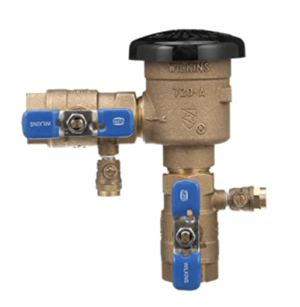Back Flow Preventer (BFP)
A Back Flow Preventer is used to protect the water source. Yours and your neighbors'. The water source can be a municipal water supply or a well, even if it's just you on your own well. Because if you contaminate your well, there is the underground source to consider, which could affect you as well as others "downstream."[1]
Why a BFP is Needed
Accidental events (like a broken water main, for example) can create a situation where water is sucked out of a contaminated source on an individual's property, back out into the public's common water source (the water main). Later, when the main is repaired, the contaminated water gets pushed back into all the surrounding houses! The contaminated source might be a pool, a hose filling a bucket of nasty garden chemicals, a hose laying in a muddy garden, an improperly installed water filter or water softener, etc. A BFP keeps any water from your property from entering the public's or a well.
What is a BFP?
Your sprinkler valve has one (anti-siphon). Your toilet has one (the air gap between your tank's filler tube and the top of the water level). Your dishwasher should have an air gap (water softeners and whole-house filters are supposed to). Your outdoor hose bibs are supposed to have one (that little brass fitting between hose and faucet). And a well is supposed to have one, etc. All are designed to keep water from flowing the wrong way.
BFP's in Pools
So, if your pool filler's outlet is well above the waterline, that's an air gap and an appropriate BFP. If that same line also has a sprinkler valve and/or a cheapie check valve type gizmo, that's even better (though it's not actually necessary). You're good to go.
If your pool filler's outlet is under the water line, you have some potential for a back-flow event. The sprinkler valve or check valve, located well above the water level, is good (it's to be 12" or 18" min., depending on local codes) as long as it is functioning. A lot would have to go wrong for a BF event to occur.
But here's the rub: sprinkler valves and cheapie check valves provide no way to determine if they work. There's no way to test them. A proper BFP for a residential water system would look something like this picture, which is good quality and can be tested.
About $60 on Amazon. All bronze. Testing ports, etc.
It becomes even more important to have a good BFP valve if there are any other valves downstream (like an auto-filler) because that would mean the BFP is under constant pressure. The anti-siphon component of a sprinkler valve is on the sprinkler side of the valve so that it's never under full pressure when used for its intended purpose, and only when the valve is open. They can handle that. But if there is an auto-filler valve downstream, the sprinkler valve's anti-siphon component is under constant, full-on pressure that they are not rated for and will eventually fail (and you'll never know it happened). So when there is a second valve, it's much more essential to have a high-quality BFP rated for the pressure (not all are), which is testable to boot.
So there you have it—more than you ever wanted to know about BFP! Based on your filler's plumbing configuration, you decide for yourself what level of protection you want.


